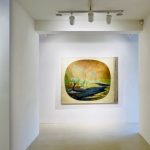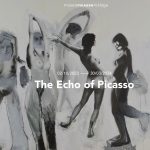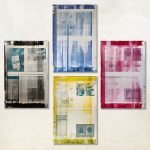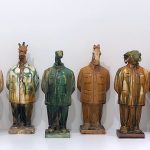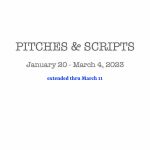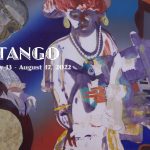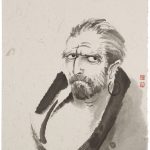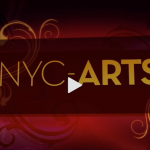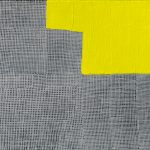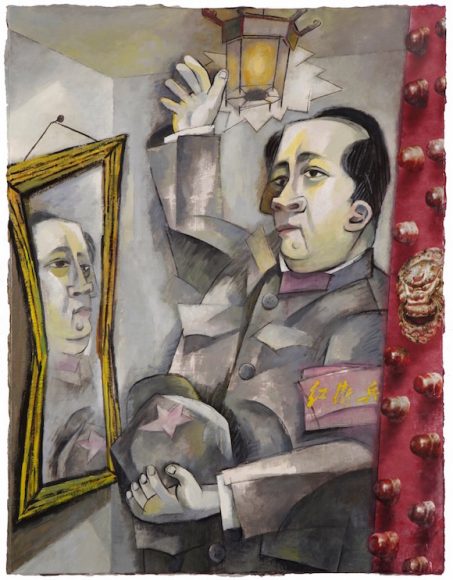
Mao, after Picasso
2012
Ink and oil on rice paper and photo collage mounted on canvas
47 x 37 in. framed (120 x 94 cm)
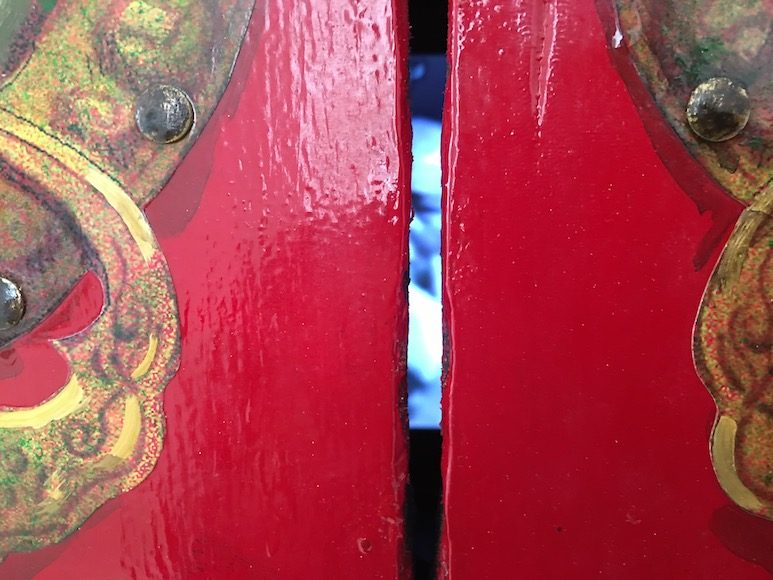
The Red Door
1995
Oil, photo collage on wooden door with video
82 x 32 x 6.5 in. (208 x 81 x 16.5 cm), detail
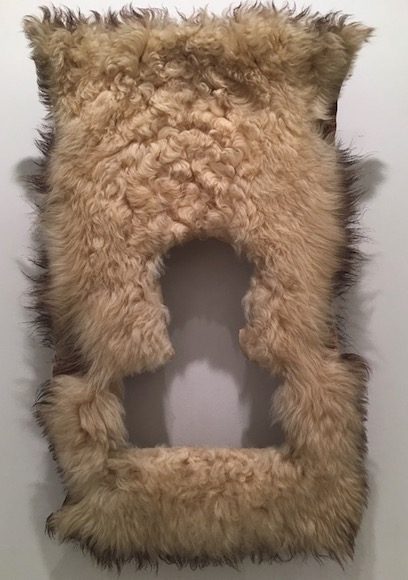
Fur Mao
1991
Fur on plywood
29 x 18 x 1.5 in. (74 x 46 x 3.8 cm)
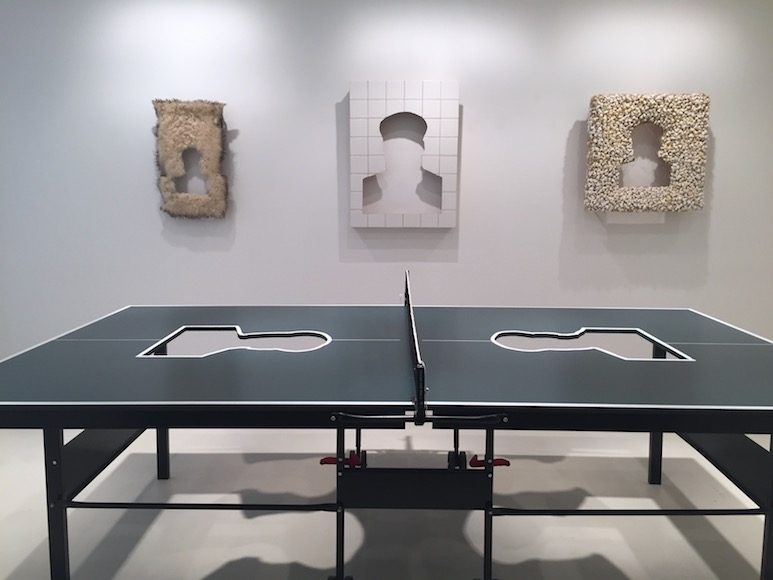
Installation view
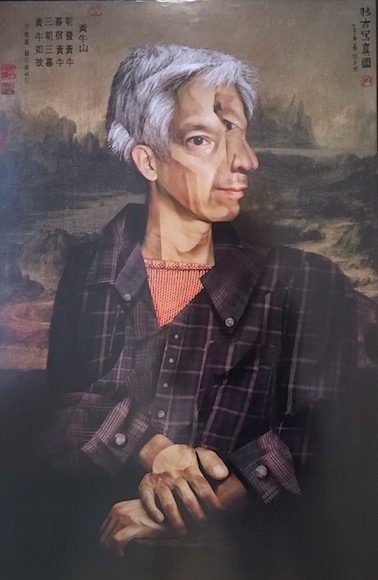
Self-Portrait in the Style of the Old Masters
2001-2017
Archival pigment print on cotton rag paper in the artist’s frame
36.5 x 26 in. framed (93 x 66 cm)
Edition of 5
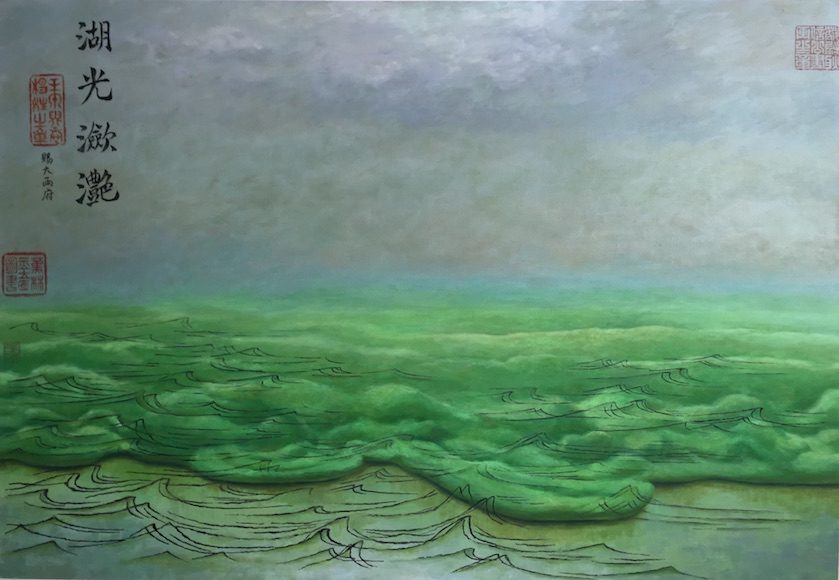
Re-Make of Ma Yuan's Water Album L (780 Years Later)
2008
Oil on canvas
50 x 72 in. (127 x 183 cm)
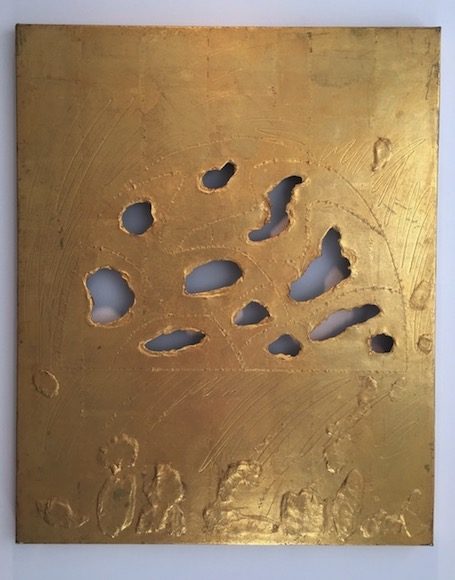
Phase Conception
1988
Gold foil, acrylic paint on layers of thick Japanese hand-made paper
31.5 x 25.7 in (80.1 x 65.2 cm)
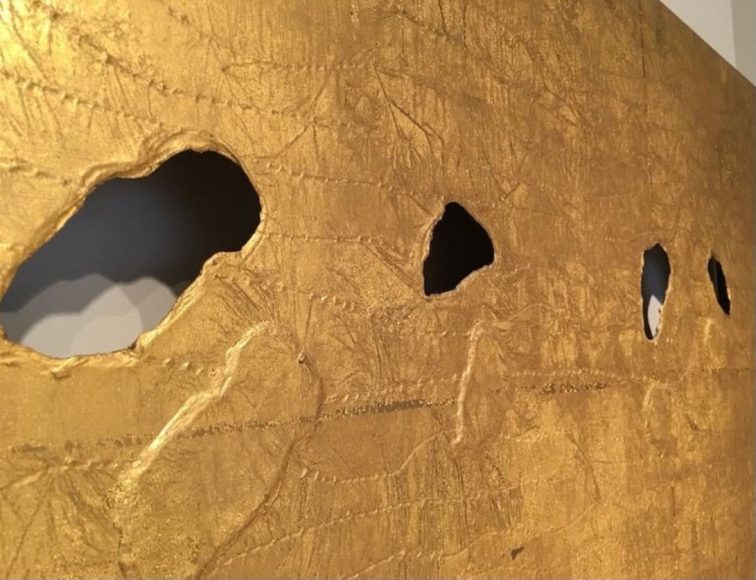
64 x 89 x 2.5 in. (163 x 226 x 6.4 cm), detail
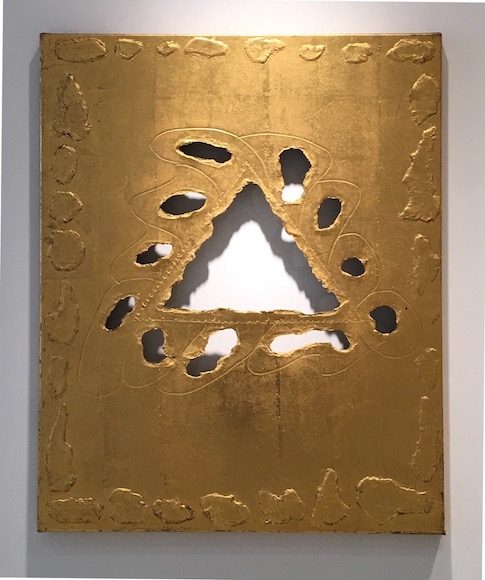
Phase Conception
1988
Gold foil, acrylic paint on layers of thick Japanese hand-made paper
31.5 x 25.7 in (80.1 x 65.2 cm)
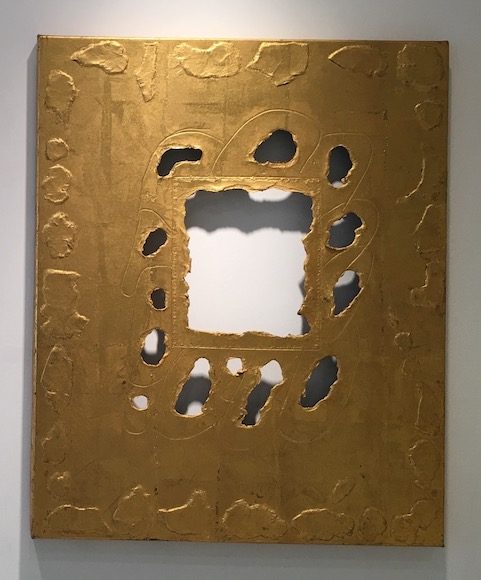
Phase Conception
1988
Gold foil, acrylic paint on layers of thick Japanese hand-made paper
31.5 x 25.7 in (80.1 x 65.2 cm)
Jennifer Baahng Gallery is pleased to present TWO ROCKS, an exhibition for artists Nobuo Sekine and Zhang Hongtu. The exhibition will showcase a selection of their paintings, sculptures, and multi-media installations, from the 1980’s and 1990’s. The exhibition will run from September 20th through October 21, 2017.
TWO ROCKS showcases the work of modern sages, Nobuo Sekine and Zhang Hongtu, from the 1980’s and 1990’s, pivotal years in their contributions to art.
September 20 – October 21, 2017
Opening reception:
Wednesday, September 20th, 2017
6-8pm
Artists in the exhibition
Nobuo Sekine
Zhang Hongtu
Biography
Zhang Hongtu
Concurrently, in the late 1980’s, Zhang, a forerunner of Political Pop Art, immigrated to New York where he would discover Pop Art against the geopolitical backdrop of the 1989 Tiananmen Square Massacre. Zhang is known for using various painting styles and media to produce artistic critiques of the Chinese Cultural Revolution, including through his appropriating images of Mao Zedong. His newer works have branched into environmental concerns, and include his classical Chinese landscape paintings, which, traditionally painted in black-and-white, are added with sensuous, toxic colors.
Born in 1943 in Pingliang, China, Zhang Hongtu is the recipient of awards, including from the Pollock Krasner Foundation in 1991 and the National Endowment for Arts in 1995. His works have been exhibited internationally, including at Bronx Museum, Kaohsiung Museum in Taiwan, Museu Picasso in Spain, Queens Museum, The Deichtorhallen in Germany, Israel Museum, and Metropolitan Museum of Art. Guggenheim Museum in New York will showcase Zhang Hongtu’s Vitrine, 1986-1995 in the upcoming exhibition “Art and China After 1989: Theater of the World.” TWO ROCKS will feature paintings, sculptures, and multi-media installations by Zhang, including Self-Portrait in the Style of the Old Masters, The Red Door, and Re-Make of Ma Yuan’s Water Album (780 Years Later).
Nobuo Sekine
Sekine is a key founder of Mono-ha, a group of artists that gained prominence in Tokyo in the late 1960’s for their rejection of the traditional ideas of representation. Primarily known as a sculptor, Sekine incorporates natural and industrial materials in his work, and his work explores the properties and interdependency of these materials with their surrounding space. In the late 1980’s, he returned to his original training as a painter, and began creating Phase Conception – a series of “paintings” of phases. The phases are made out of thick Japanese handmade paper, cut out, torn, pasted back onto the remaining surface, and coated with either gold leaf or black lead. They are based on a topological geometry concept as applied to space, which is that the continuous transformation of form does not affect the sum total of the form’s mass.
Born 1942 in Saitama prefecture, Japan.
Graduated in 1968 with a M.F.A. in Painting, studying under artist Yoshishige Saito.
From 1968 into the 1970s, Sekine worked internationally as a central figure of “Mono-ha” (translated literally as “School of Things”), a movement considered instrumental in the formation of postwar Japanese art. Phase—Mother Earth, an earthwork first constructed in Suma Rikyu Park, Kobe, in 1968, is widely recognized as marking the beginning of Mono-ha, and as one of the most iconic works of this period in Japan.
In 1970, Sekine represented Japan in the Venice Biennale with Phase of Nothingness, consisting of a large natural stone supported by a mirrored stainless steel column. The sculpture is now in the permanent collection of the Louisiana Museum of Modern Art in Humlebæk, Denmark. Sekine remained in Europe after the Biennale, exhibiting in Italy, Switzerland, and Denmark. Informed by his observations on art and architecture, urban and public space in Europe, Sekine returned to Japan to establish Environmental Art Studios, a public art agency, in 1973.
From 1978 to 1979, Sekine returned to Europe for the traveling exhibition of his work Phase of Nothingness—Black. The solo exhibition toured from the Künsthalle Dusseldorf, Germany, to the Louisiana Museum of Modern Art, Humlebæk, Denmark; the Kröller-Müller Museum, Otterlo, Netherlands; and the Henie-Onstad Art Centre, Høvikodden, Norway.
In 1993, Sekine and Phase—Mother Earth were cited by 30 participating critics, curators, and journalists in the survey “Sengo bijutsu besuto ten” (Postwar art best ten), featured in the prominent art magazine Bijutsu Shinchō.
In 2001, Sekine was included in the exhibit Century City at the Tate Modern, London, for his critical role in the burgeoning Tokyo art scene between 1969 and 1973. He also participated in the Gwangju Biennale, Korea, the same year.
Selected exhibitions of Sekine and Mono-ha include Reconsidering Mono-ha, The National Museum of Art, Osaka, 2005; What is Mono-Ha? Beijing Tokyo Art Projects, Beijing, 2007; Requiem for the Sun: The Art of Mono-ha, Blum & Poe, Los Angeles, 2012; Art Unlimited, Art Basel, Basel, 2013; Prima Materia, Punta Della Dogana, Venice, 2013; Parallel Views: Italian and Japanese Art from the 1950s, 60s, and 70s,The Rachofsky Warehouse, Dallas, Texas, 2013.
Sekine is currently Visiting Professor at Tama Art University and Kobe Design University.
Selected Solo Exhibitions
2014 Blum & Poe, Los Angeles, CA
2011 Re-creations 1970/2011, Kamakura Gallery, Kamakura, Japan Monogatari, Shanghai Sculpture Space, Shanghai,China
2010 BE-UP-ART, Tokyo, Japan
2009 Center Gallery, Yokohama, Japan
Kawagoe Gallery, Kawagoe, Japan
2008 Gallery Bijutsu Sekai, Tokyo, Japan Gallery Art Composition, Tokyo, Japan
PYO Gallery, Seoul, Korea
2007 Center Gallery, Yokohama, Japan Gallery Bijutsu Sekai, Tokyo, Japan
Shina Gallery, Kyoto, Japan
2006 Saint Paul Gallery, Maebashi, Japan Gallery Bijutsu Sekai, Tokyo, Japan
2005 Gallery Bijutsu Sekai, Tokyo, Japan
MANIF 11! ’05 SEOUL, Seoul Art Center, Seoul, Korea
2004 Movement, Feeling, Environment, Tokyo Gallery + BTAP, Beijing,China Art Dune, Hamamatsu, Japan
Phase of Nothingness – Black from ’78-’79 solo exhibition in Europe, Kamakura Gallery, Kamakura, Japan
2003 Kawagoe City Art Museum, Saitama, Japan
2001 Art Dune, Hamamatsu, Japan
1999 Museum Shokyodo, Aichi, Japan
1998 Saint Paul Gallery, Maebashi, Japan
1997 Kawagoe Gallery, Kawagoe, Japan Art Dune, Hamamatsu, Japan
1996 Archaeology of Phase – Mother Earth, Otani Memorial Art Museum, Nishinomiya, Japan
1995 Gallery Art Point, Tokyo, Japan Galleri Akern, Kongsberg, Norway
1994 Art Dune, Hamamatsu, Japan
1993 Sakura Gallery, Nagoya, Japan
1992 Museum Shokyodo, Aichi, Japan
Nobuo Sekine, Soko Tokyo Gallery, Tokyo, Japan
1991 Kawagoe Gallery, Kawagoe, Japan
Tenmaya Department Store, Okayama, Japan
Anshindo Gallery, Shizuoka, Japan Art Dune, Hamamatsu, Japan
1990 Tenjuen, Niigata, Japan
Soko Museum, Niigata, Japan Atelier Gallery, Niigata, Japan
Sogo Department Store, Hiroshima, Japan
Seibu Department Store – Studio 5, Tokyo,Japan Mitsukoshi Department Store, Tokyo, Japan
1989 Kodosha, Ichinoseki, Japan Gallery Lamia, Tokyo, Japan
Chikugo Gallery, Kurume, Japan
Mitsui Gallery, Matsudo, Japan
Gallery TAK, Yokohama, Japan
Susono Art House, Susono, Japan
Kozaido Gallery, Tokyo, Japan
Kobundo Gallery, Obihiro, Japan Gojuichiban-kan Gallery, Aomori, Japan Gallery Picasso, Maebashi, Japan Katsuyama Isozaki Hall, Fukui, Japan Stempfli Gallery, New York, New York Umeda Modern Art Museum, Osaka, Japan
1988 Gallery M, Obama, Japan
Art Dune, Hamamatsu, Japan
Kozaido Gallery, Tokyo, Japan Nishida Gallery, Nara, Japan
Soh Gallery, Tokyo, Japan Anshindo Gallery, Shizuoka, Japan Gallery Kura, Kitakyushu, Japan We Gallery, Omiya, Japan
1987 Ginza Jiyugaoka Gallery, Tokyo Gallery Te, Tokyo, Japan
Kawagoe Gallery, Kawagoe, Japan Sakura Gallery, Nagoya, Japan Tokyo Gallery, Tokyo, Japan
1985 Akiyama Gallery, Tokyo, Japan
1983 Sekine and Environment Art Studio, Stripe House Museum, Tokyo, Japan
1982 Sekine’s Prints and Sculptures: Cross Country 7500Km, Keneko Art Gallery, Tokyo, Japan
1981 Kaneko Art Gallery, Tokyo, Japan Sakura Gallery, Nagoya, Japan
1980 Kaneko Art Gallery, Tokyo, Japan Tokyo Gallery, Tokyo, Japan
1978 Nobuo Sekine: Skulptor 1975-1978, Kunsthalle, Dusseldorf, Germany; traveled to Louisiana Museum of Art, Humlebæk Denmark; Kröller-Müller Museum, Otterlo, Netherlands; Henie-Onstad Art Centre, Høvikodden, Norway
1977 Kaneko Art Gallery, Tokyo, Japan Sakura Gallery, Nagoya, Japan
Tokyo Gallery, Tokyo, Japan
1976 Gallery Dori, Tokyo, Japan
1975 Sakura Gallery, Nagoya, Japan
1973 Tokyo Gallery, Tokyo, Japan
1971 Gallery Krebs, Bern, Switzerland Gallery Birch, Copenhagen, Denmark
1970 Galleria La Bertesca, Genova, Italy Genoa Gallery Modulo, Milan, Italy
1969 Tokyo Gallery, Tokyo, Japan
2014 Group “Genshoku” and Ishiko Junzo 1966-1971, Shizuoka PrefecturalMuseum of Art, Shizuoka, Japan
Mono-ha, Tabloid Gallery, Tokyo, Japan
Mono-ha by Anzai: Photographs 1970-1976, Zeit-Foto Salon, Tokyo,Japan Other Primary Structures (Others 2: 1967 – 1970), Jewish Museum,
New York, NY
Mono-ha Artists, Museum of Contemporary Art, Karuizawa, Japan
The Hara Museum Collection at 35, Hara Museum of Contemporary Art, Tokyo, Japan
2013 Prima Materia, Punta della Dogana, Venice, Italy
Tricks and Vision to Mono-ha, Tokyo Gallery + BTAP, Tokyo, Japan Parallel Views: Italian and Japanese Art from the 1950s, 60s, and 70s, The Warehouse, Dallas, TX
2012 Ends of the Earth: Land Art to 1974, Museum of Contemporary Art, Los Angeles, CA; traveled to Haus der Kunst, Munich
Tokyo 1955-1970, Museum of Modern Art, New York, NY
Requiem for the Sun: The Art of Mono-ha, Blum & Poe, Los Angeles, California The ‘70s in Japan: 1968-1982, Museum of Modern Art, Saitama, Japan; traveled to Hiroshima City Museum of Contemporary Art, Hiroshima, Japan
The Artists of Mono-ha and Its Era, Rakusui-tei Museum of Art, Toyama,Japan
2011 Gallery’s Collection Exhibition: Mono-ha, Tokyo Gallery + BTAP, Tokyo,Japan
2010 Masan Munsin International Sculpture Symposium, Munsin Art Museum, Masan, Korea
Tokyo Gallery + BTAP 60th Anniversary Exhibition, Tokyo Gallery + BTAP, Tokyo, Japan
Yanpyon Environment Festival, Korea
Printing Exhibition of Shanghai World Expo 2010, Shanghai, China
Micro Salon 60, Tokyo Gallery + BTAP, Tokyo, Japan
2009 Drawing Story I 1960–1990, Tokyo Gallery + BTAP, Tokyo, Japan
2008 Tamagawa Art Line Project, Tokyo, Japan
Art Scene Revived, Tokyo Gallery + BTAP, Tokyo, Japan
2007 What is Mono-ha?, Beijing Tokyo Art Project, Beijing,China
Nobuo Sekine & Mitsukuni Takimoto, Yokohama Portside Gallery, Yokohama, Japan
2006 Public Art, Gallery NOVITA, Aomori, Japan
Memorial for Yoshiaki Tono, Gallery TOM, Tokyo, Japan
Mono-ha: Lee Ufan, Kishio Suga, Nobuo Sekine – from the 1970’s, Soh Gallery, Tokyo, Japan
2005 Reconsidering Mono-ha, National Museum of Art, Osaka,Japan
2004 Kim Tschang-Yeul, Sekine Nobuo & Susumu Sakaguchi, Gallery Bijutsu Sekai, Tokyo, Japan
The New Tokyo Gallery Exhibition, Tokyo Gallery + BTAP, Tokyo,Japan
2003 The 20th Anniversary of Gallery Q, Gallery Q, Tokyo, Japan
2002 Sculpture Project, Busan Biennale, Busan, Korea
Memorial for Yoshishige Saito, Kawamura Gakuen Art Hall, Tokyo, Japan
2001 Century, Tate Modern Art Gallery, London, UK Mono-ha, Kamakura Gallery, Tokyo, Japan
Mono-ha, Kettle’s Yard Art Gallery, Cambridge, UK
Retrospective Exhibition for Nagaoka Museum Prize 1964-68, The Niigata Prefectural Museum of Modern Art, Niigata, Japan
2000 Gwangju Biennale, Gwangju, Korea
Modern Art of Japan: Monet de Paris, French National Mint Bureau, Paris, France
1998 Lumieves – Light – Rediscovery of Stained Glass, TN Probe, Tokyo, Japan 1997 Modern Art from a Collector’s View Point: Yamamura Collection, Hyogo
Prefectural Museum of Art, Kobe, Japan Street Museum, Kawagoe, Japan
1996 Inside and the Outside of Art, Itabashi Art Museum, Tokyo, Japan 1970-Material and Perception – Mono-ha and Artists Who Ask Root, Saint Ratienu Museum, France
1995 Archeology of Phase – Mother Earth, Otani Memorial Art Museum, Nishinomiya, Japan
Japanese Culture: The Fifty Postwar Years, Meguro Museum of Art, Tokyo, Japan; traveled to Hiroshima City Museum of Contemporary Art, Hiroshima, Japan; Fukuoka Prefectural Museum of Art, Fukuoka, Japan; Hyogo Prefectural Museum of Art, Kobe, Japan
46th Venice Biennale: ASIANA Contemporary Art from The Far East, Palazzo Vendramin Calergi, Venice, Italy
Matter and Perception 1970: Mono-ha and the Search for Fundamentals, Museum of Fine Arts Gifu, Gifu, Japan; traveled to Hiroshima City Museum of Contemporary Art, Hiroshima, Japan; Kitakyushu Municipal Museum of Art, Kitakyushu, Japan; Museum of Modern Art, Saitama, Japan; Museum of Modern Art Sain-Étienne, Saint-Étienne, France
1994 Landscape of Stone, Dockyard Garden, The Landmark Tower Yokohama, Yokohama, Japan
Mono-ha, Kamakura Gallery, Tokyo, Japan
Different Natures, La Virreina, Barcelona, Spain
Memorial for Yaeko Fujita: Artists and Sakura Gallery, Sakura Gallery, Nagoya, Japan
Japanese Art after 1945: Scream against the Sky, Yokohama Museum of Art, Yokohama; traveled to Guggenheim Museum Soho, New York, NY; San Francisco Museum of Modern Art, San Francisco, CA
ASIANA Contemporary Art from the Far East, Parazzo, Italy
1993 Imura Art Gallery, Kyoto, Japan Konishi Gallery, Kyoto, Japan
Oomitsu Collection, Niigata City Art Museum, Niigata, Japan
Differentes Natures, Visions de l’Art Contemporain, Galerie Art 4 et Galerie de l’Esplanade, Paris, France
Exposition Différentes Natures, Galerie Art La Defense, Paris, France
1992 Avantguardie Giapponesi degli anni 70, Galleria Comunale d’Arte Moderna di Bologna; traveled to Setagaya Art Museum, Tokyo, Japan
1991 Gallery Gen-Group Show, Tokyo, Japan
70’s-80’s Contemporary Art: Mono-ha, Kamakura Gallery, Tokyo, Japan
1990 Yokohama Business Park, Yokohama, Japan
1989 Japanese Open-Air Sculptures, Middelheim Museum, Antwerp, Belgium
1988 Mono-ha: La Scuola delle cose, Museum Laboratorio di Arte Contemporanea, Rome Italy
Seen by Hands, Seibu Department Store, Yurakucho, Tokyo,Japan
1987 Art in Japan since 1969: Mono-ha and Post Mono-ha, Seibu Museum of Art, Tokyo, Japan
Nobuo Sekine and Koji Enokura Recent Print Works, Naruse Murata Gallery, Tokyo, Japan
Tokyo Gallery Group Exhibition, Tokyo Gallery, Tokyo,Japan
1986 Mono-ha, Kamakura Gallery, Tokyo, Japan
Lee Ufan, Nobuo Sekine, Kishio Suga: Methods of the 1970s, Soh Gallery, Tokyo, Japan
Le Japon des Avant-Gardes, Centre Georges Pompidou, Paris, France
1984 Human Documents ’84/’85-3, Tokyo Gallery, Tokyo, Japan
Art of Present Time. Wood and Paper-Dialogue with Nature, Gifu Prefectural Museum, Gifu, Japan
Development of Contemporary Sculpture, Gallery Seiho, Tokyo,Japan Sculpture Japonaise Contemporaine, Galerie Jullien-Cornic, Paris, France
1983 Figure of Wood and Esprit, Saitama Prefectural Museum, Tokyo,Japan
1981 Turning Point of Contemporary Art of 1960’s, National Museum of Modern
Art, Tokyo, Japan; traveled to the National Museum of Modern Art, Kyoto, Japan Modern Japanese Sculpture, Kanagawa Prefectural Museum of Modern Art, Kanagawa, Japan
Japanese Contemporary Art, The Korean Culture and Arts Foundation, Seoul, Korea
The 1960’s: A Decade of Change in Contemporary Japanese Art, National Museum of Modern Art, Tokyo, Japan
1980 History of Contemporary Sculpture, Kanagawa Prefectural Hall Gallery, Kanagawa, Japan
1977 Japan Art-Festival, Tokyo Central Museum, Tokyo, Japan Voices in the Modern Age
Tokyo Gallery Exhibition, Tokyo Gallery, Tokyo, Japan
1976 10th International Biennale Exhibition of Prints in Tokyo, The National Museumof Modern Art, Tokyo, Japan
1975 Contemporary Art Exhibition from 1950 to 1975, Central Museum, Tokyo, Japan
1974 Two-Man Show with Kuniichi Sima, Gallery Coco, Kyoto, Japan 11th Tokyo Biennale, Tokyo, Japan
Contemporary Sculpture Exhibition of 20 Artists, Tokyo Central Museum, Tokyo, Japan
Japan Art Exhibition, Germany
Contemporary Sculpture Symposium, Tochigi Prefectural Museum of Fine Arts, Japan
1973 8th Japan Art-Festival, Tokyo, Japan
11th Contemporary Art Exhibition of Japan, Tokyo Metropolitan Art Museum, Tokyo, Japan
1971 10th Contemporary Art Exhibition of Japan, Tokyo Metropolitan ArtMuseum, Tokyo, Japan
Tokyo Gallery 1971, Tokyo Gallery, Tokyo, Japan
1970 Art Exhibition of World EXPO 1970, Suita, Osaka, Japan 35th Venice Biennale, Venice, Italy
Human Documents ’70-3, Tokyo Gallery, Tokyo, Japan
1969 6th Paris Biennale, Paris, France
9th Contemporary Art Exhibition of Japan, Tokyo Metropolitan Art Museum, Tokyo, Japan
1st International Contemporary Sculpture Exhibition, Hakone Open-Art Museum, Tokyo, Japan
9 Visual Points, Muramatsu Gallery, Tokyo, Japan
Tricks & Vision: Stolen Eyes, Tokyo Gallery, Tokyo, Japan
Trend of Japanese Contemporary Art, National Museum of Modern Art, Kyoto, Japan
Japanese Artist Drawing, Tokyo Gallery, Tokyo, Japan
1968 OOXPLAN, Muramatsu Gallery, Tokyo, Japan
8th Contemporary Art Exhibition of Japan, Tokyo Metropolitan Art Museum, Tokyo, Japan
1st Contemporary Sculpture Exhibition, Suma Palace Park, Kobe, Japan 5th Exhibition, Museum of Contemporary Art, Nagoya, Japan
1967 Two-Man Show, Tsubaki Kindai Gallery, Tokyo, Japan 11th Shell Art Exhibition, Tokyo, Japan
OOOPLAN, Muramatsu Gallery, Tokyo, Japan Universiad, Tokyo, Japan
Catalogues and Monographs
2013 Atkins, Robert. Artspeak: A Guide to Contemporary Ideas, Movements, and Buzzwords, 1945 to the Present. New York: Abbeville Press, 2013.
2012 Ends of the Earth: Land Art to 1974. Los Angeles: Museum of Contemporary Art, 2012.
Mono-ha Artists and the Era. Toyama: Rakusui-tei Museum of Art, 2012. Yoshitake, Mika. Requiem for the Sun: The Art of Mono-ha. Los Angeles: Blum & Poe, 2012.
2011 Monogatari: Nobuo Sekine Arts Exhibition 1970-2011. Shanghai:Shanghai People’s Fine Arts Publishing House, 2011.
2008 Sekine Nobuo. China: Pyo Gallery, 2008.
2007 What is Mono-ha? Texts by Huang Du, Charles Merewether, Yusuke Nakahara,
Yukihito Tabata, and Hozu Yamamoto. Tokyo: Tokyo Gallery + BTAP,2007. 2006 Sekine, Nobuo. Fukei no yubiwa. Tokyo: Tosho Shinbun,2006.
2004 Beijing Tokyo Art Projects. Movement, Feeling, Environment: Nobuo Sekine, Environment Art Studio. Beijing: Beijing Tokyo Art Projects, 2004.
2003 Sekine, Nobuo. Concerning with “Environment Art” Sekine. Kawagoe, Japan: Kawagoe Shiritsu Bijutsukan, 2003.
2001 Mono-ha – School of Things. Texts by Tatehata Akira, Simon Groom, Lee Ufan, Cambridge: Kettle’s Yard, 2001.
1996 Isō-Daichi no kōkogaku (Archaeology of Phase-Mother Earth). Nishinomiya: Ōtani Memorial Art Museum, 1996.
Sekine, Nobuo, Masahiro Shino. “Iso, daichi” no kokogaku. Nishinomiya, Japan: Otani Memorial Museum of Art, 1996.
1995 Kamakura Gallery. Mono-ha 1994. Tokyo: Kamakura Gallery, 1995.
1994 Munroe, Alexandra. Japanese Art After 1945: Scream Against the Sky. New
York: Harry N. Abrams, 1994.
1992 Sekine, Nobuo. Sekine: A Message from Environment Art Studio. Tokyo:Process Architecture, 1992.
1989 Sekine, Nobuo, and Yoshifumi Hayashi. Phase Conception II.Tokyo: Environment Art Studio; Niigata, Japan: Loft Museum Ten,1989.
1987 Sekine, Nobuo. Sculpture of Scenery: Works of Nobuo Sekine + Environment Art Studio. Tokyo: Process Architecture, 1987.
1986 Mono-ha. Text by Toshiaki Minemura. Tokyo: Kamakura Gallery, 1986.
1985 Sekine, Nobuo. Half-Autobiography: Art and Urban and Pictoral Fiction.Tokyo:
PARCO Shuppan, 1985.
1983 Sekine, Nobuo, and Environment Art Studio. From Landscape to Open Space. Tokyo: Shotenkenchiku-Sha, 1983.
1978 Nobuo Sekine: Skulptur 1975-1978. Exh. cat. Humlebaek, Denmark: Louisiana Museum, 1978.
Sekine Nobuo 68-78. Cat. raisonné. Text by Sekine Nobuo. Tokyo:Yuria pemuperu kōbō, 1978.
Sekine Nobuo: 1968-78. Tokyo: Julia Pempel Atelier, 1978.
1977 Sekine Nobuo. Tokyo: Tokyo Gallery and Kaneko Art Gallery; and Nagoya: Sakura Gallery, 1977.
1969 Sekine Nobuo. Text by Nakahara Yūsuke. Tokyo: Tokyo Gallery, 1969.
Articles and Reviews
2014 Herriman, Kat. “The Simple Complex.” Wmagazine.com, January 16, 2014.
2013 Barrilà, Silvia Anna. “Giapponesi graditi all’America.” Il Sole 24 Ore, no. 581 (October 2013): 20-21.
Miyamura, Noriko, ed. Enjoy! Contemporary Art! Tokyo: Yosensha, 2013.
Ruiz, Cristina. “The Lost Decades: Why the Past Is Back to Stay.” ArtNewspaper (Art Basel ed.), June 14-16, 2013.
Cembalest, Robin. “New Perspectives on Art.” Vogue (Japan), no. 162 (February 2013): 280-81.
Russell, Heather. “Nobuo Sekine and the Japanese Mono-haMovement.” Artnet.com, March 13, 2013.
Morikawa, Manami. “Special Report: ‘Tokyo 1950-1975: A New Avant-Garde’ Exhibition.” Bijutsu Techō 65, no. 982 (April 2013): 98-112.
2012 Akel, Joseph. “Requiem for the Sun: The Art of Mono-ha, GladstoneGallery.” Modern Painters 24, no. 8 (October 2012): 92.
Balestin, Juliana. “Group Exhibitions ‘Requiem for the Sun: The Art ofMono-ha’ at Gladstone Gallery, New York.” Purple.fr, July 22, 2012.
Berardini, Andrew. “Mono-ha, the Japanese ‘School of Things’ at Blum & Poe.” LA Weekly, March 8, 2012.
Bryan-Wilson, Julia. “Ends of the Earth: Land Art to 1974.” Artforum 51, no. 3 (November 2012): 269-70.
Cembalest, Robin. “New Perspectives on Art.” Vogue (Japan), no. 162 (February 2013): 280-81.
Chang, Ian. “Requiem for the Sun.” Frieze, no. 148 (June-August 2012): 206. Chong, Doryun. Tokyo 1955-1970: A New Avant-Garde. New York: Museum of Modern Art, 2012.
Drohojowska-Philp, Hunter. “Mono-ha Revisited.” KCRW.com, February 23, 2012, http://www.kcrw.com/etc/programs/at/at120223mono-ha_revisited.
Favell, Adrian. “Mono-ha in LA.” ARTiT.com (blog), February 27, 2012, http://www.art-it.asia/u/rhqiun/zMnqaA0XIdfS8NHW5v2x/.
Ferguson, Russell. “Best of 2012.” Artforum 51, no. 4 (December 2012): 218. From Postwar to Postmodern: Art in Japan 1945-1989 : Primary Documents. New York: Museum of Modern Art, 2012.
Haber, John. “Zen and the Art of Minimalism.” Haberarts.com, August 3, 2012, http://www.haberarts.com/monoha.htm.
Halperin, Julia. “Blum & Poe’s Survey Touches Off Mono-ha Mania – And It’s Coming to New York.” Artinfo.com, April 23, 2012, http://www.artinfo.com/news/story/800839/blum-poes-survey-touches-off-mono- ha-mania-%E2%80%94%C2%A0and-its-coming-to-new-york.
Halperin, Julia. “One-Line Reviews: Our Staff’s Pithy Takes on the Mono-ha Retrospective, Summer’s First Group Shows, and More.” Artinfo.com, June 29, 2012, http://www.artinfo.com/photo-galleries/one-line-reviews-our-staffs-pithy- takes-on-the-mono-ha-retrospective-summers-first-group-shows-and-more#one- line-reviews-our-staffs-pithy-takes-on-the-mono-ha-retrospective-summers-first- group-shows-and-more/?image=2&_suid=135542772166208163063190438622. Hiro, Rika. “Exhibition Report – Requiem for the Sun: The Art of Mono-ha inLA.” Bijutsu techō, no. 6 (June 2012): 212-19.
Hiro, Rika. “‘Requiem for the Sun: The Art of Mono-ha’ in Los Angeles: Encounters with Objects, Mono-ha, and the World.” Bijutsu Techō (English Supplement), no. 2 (Spring 2012): 3-5.
Johnson, Caitlin. “Mono-ha at Blum & Poe.” Los Angeles I’m Yours, April 9, 2012, http://www.laimyours.com/13859/mono-ha-at-blum-poe/.
Kee, Joan. “Requiem for the Sun: The Art of Mono-ha.” Artforum 50, no. 9 (May 2012): 316.
Knight, Christopher. “Worldly, Refined.” Los Angeles Times, March 21, 2012. Momen, Motin. “Requiem for the Sun: The Art of Mono-ha.”StyleZeitgeist.com (blog), July 2012, http://www.sz-mag.com/news/2012/07/mono-ha/.
Myers, Holly. “Simple, Elegant Design.” Los Angeles Times, March 9, 2012. Raffel, Amy. “Gladstone Gallery, Requiem for the Sun: The Art of Mono-ha.” Workspacesllc.com (blog), July 26, 2012, http://www.workspacesllc.com/blog/gladstone-gallery-requiem-for-the-sun-the- art-of-mono-ha-until-august-3/.
Rawlings, Ashley. “Turning the World Inside Out: A Major Survey of Mono-ha in Los Angeles.” Art in Australia 49, no.4 (Winter 2012): 580-83.
Ritter, Gabriel. “Requiem for the Sun: The Art of Mono-ha.” ArtAsiaPacific, no.79 (July-August 2012): 120.
Schad, Ed. “Requiem for the Sun.” ArtReview, no. 59 (May 2012): 122-23. Yau, John. “Nobuo Sekine and Charles Ray and Their Sculptures Filledwith Liquid.” Hyperallergic.com, July 29, 2012.
2011 Wallis, Stephen. “Mono-ha Moment.” Art in America 99, no. 11 (December2011): 65-66.
2007 Minemura, Toshiaki. “Difference in the Development of ‘Mono’: On a Visit tothe What is Mono-ha? Exhibition in Beijing.” Mainichi Shimbun (evening edition),
June 21, 2007.
Rawlings, Ashley. “An Introduction to Mono-ha.” TokyoArtBeat.com, September 8, 2007, http://www.tokyoartbeat.com/tablog/entries.en/2007/09/an-introduction-to- mono-ha.html.
2004 Nakano, Minoru. “Zen’ei geijutsu no jidai (4) monoha: sozai wo chokushi,
hihyōsei tsuyoku ‘bungē hyakuwa’” (Era of the Avant Garde (4) Monoha:Gazing at material, hard criticality ‘100 literary stories’). Nihon keizai shinbun, December 26, 2004.
Ōtagaki Minoru. “Art shin ko ima kyouto no jikū ni asobu 3 sekine nobuo ‘isō daichi’ to ginkakuji to kogetsudai, jyō” (Art new, old and now playing in Kyoto space-time: Sekine Nobuo and Ginkakuji, Kogetsudai, vol. 1). Kyoto shinbun,
July 3, 2004.
Ōtagaki, Minoru. “Art shin ko ima kyouto no jikū ni asobu 3 sekine nobuo ‘isō daichi’ to ginkakuji kogetsudai, jyō” (Art new old and now playing in Kyoto space- time: Sekine Nobuo and Ginkakuji, Kogetsudai, vol. 1). Kyoto shinbun, July 10, 2004.
Sugawara, Norio. “Kinyō koramu nankai? Na gendai bijutsu, mijika ni kanjiru kokoromi” (Friday column impenetrable? Contemporary art attempts at familiarity). Yomiuri shinbun (evening ed.), January 16, 2004.
Sumi, Akihiko. “Tokushū nihonn kingendai bijutsushi 1905-2005: Lee Ufanjidai
to kokkyō wo koeta ‘deai’ wo motomete” (Japanese modern art history 1905- 2005: Lee Ufan seeking encounters beyond history and borders). Bijutsu Techō, July, 22-31, 2004.
Sumi, Wakio. “’Isō Daichi’ sai-sēisaku 2003 shimatsuki” (Revisiting ‘Phase
Mother Earth’ document 2003). National Museum of Art, Osaka, no. 138 (March 2004): 3.
2002 “Cover Hero: Environmental Artist 20 Sekine Nobuo.” Bien, no. 20 (2002):4-9. Mita, Haruo. “Bijutsu Sekine Nobuo ten toshi kūkan to kakawaruniwa” (In orderto engage with urban space). Mainichi Shinbun, April 21, 2002.
Sasaki, Hiroko, Sekine Nobuo, Hamada Gōshi. “Talk Sairoku Sasaki HirokoX Sekine Nobuo uchinaru iro uchinaru katachi kaiga to chōkoku wo meguru orijinarityi no yukue” (Re-recording Talk Sasaki Hiroko X Sekine Nobuointernal color internal form the future of originality in painting and sculpture). Bijutsu Techō (December 2002): 151-153.
Sawaragi, Noi. “Tokubetsu teisai sensō to banpaku kanketsuron zenpen mō hitotsu no sensō bijutsu sokoniwa itsumo ga atta” (Special article thewar and the world’s fair conclusion part one the other wartime art there were always ‘rocks’ there). Bijutsu Techō (August 2002): 147-159.
Tsuchiya, Seiichi. “Dai 12 kai gēijutsu hyōron boshū nyūsensaku happyo
nakushita monono arika wo megutte Saito Yoshishige, 1973, saisēsaku” (12th art criticism competition selection honorable mention on the whereabouts ofthings lost Saito Yoshishige reproduction). Bijutsu Techō (May 2002):152-159.
2001 Cowan, Amber. “The Five Best Shows Nationwide: Mono-ha: School ofThings.” Times (London), February 6, 2001.
Kumagaya, Isako. “Enokura Kōji ‘kabe’ sakuhin wo chūshin ni” (Centering around Enokura Koji’s ‘wall’ piece). Museum of Contemporary Art Tokyo Bulletin, no. 6 (2001): 23-28.
Reed, Robert. “How Mono-ha shocked the world.” Daily Yomiuri, April 19, 2001. Safe, Emma. “Mono-ha – School of Things.” Art Monthly, no 248 (July-August 2001): 34-35.
Sekine, Nobuo. “Saito Yoshishige wo otono nai hakushu de okutta” (Wegave Saito Yoshishige a silent round of applause.” Aida (October 2001): 6.
“Zenēi bijutsu no nihon Matsuri no zenya” (The avant garde’s Japan the evening before the festival). Bijutsu Techō (October 2001): 93.
1999 Reed, Robert. “Terror in the Bronze.” Winds (January 1999):30-32.
1997 Chiba, Shigeo. “Tsuitō Yoshida Katsuro mirukoto no hirogari” (Inmemoriam Yoshida Katsuro the expanse of looking). Hanga gējutsu, no. 106 (1997): 98-103. Sawaragi, Noi. “Rensai nihon gendai bijutsu dai 7kai ‘monoha’ towa nanika” (Series Japanese contemporary art part 7 what is ‘monoha’). Bijutsu Techō (January 1997): 163-183.
Suzuki Kenshi. “Ki ga ringo kara ochiru kokuritsu kokusai bijutsukan ‘jūryoku sengo bijutsu no zahyōjin’ ten” (The tree falls from the apple: National Museum of Art, Osaka exhibition “Gravity coordinates of post-war art”). Bijutsu Techō (January 1997): 188-193.
Tani Arata, Mita Haruo, Sugawara Norio, and Takashima Naoyuki. “Nihon-teki hyōgen kūkan to insutarēshon” (Japanese spatial expression and installation). Bijutsu Techō (November 1997): 80-96.
1996 Hyōgyoku, Masahiko. “Gendai bijutsushi no ‘jiken’ ou ‘bijutsu no kōkogaku’ten” (An “incident” in contemporary art). Nihon keizai shinbun, July 10, 1996.
Shiraki, Midori. “Tenhyō Bijutsu no kōkogaku—zenēi bijutsu no nijikensaikenshō” (The archeology of art—re-evaluating two incidents in the avant garde). Nihon Keizai Shinbun (Osaka ed.), July 5, 1996.
Sugawara, Norio. “Torendo in bijutsu aitsugu ‘sengo’ kikaku kenshō womeguru taishō-teki shuhō” (Trends in art: a string of ‘post war’ shows contrast methodology in their examination). Yomiuri shinbun, July 10, 1996.
Tanaka, Sanzōu. “Mono no ninshiki saguru sugata ‘Enokura Koji isaku’ ten to ‘bijutsu no kōkogaku’ ten (bijutsu)” (The state of searching for theunderstanding
of things exhibits ‘posthumous works by Enokura Koji’ and the ‘archeology of art’). Asahi Shinbun, June 27, 1996.
1995 “Biji-shūi 1970nen Bushitsu to chikaku monoha to kongen wo tou sakka tachi” (Gleaning/re-examining good things 1970 Material and perception mono-ha, artists who interrogate origin). Bijutsu Techō (March 1995): 148.
Hyōgyoku Masahiko. “Bijutsu no ashimoto wo tou tamemi, ‘1970nen—bushitsu to chikaku’ ten” (Questioning the foundation of material, exhibition “1970—material and perception”). Nihon keizai shinbun, Novermber 9, 1995.
Jacob, Mike. “The Hole and its Parts: Sculptor pursues ‘Special MentalState’” Daily Yomiuri, January 1995.
Koshimizu, Susumu. “Tokubetsu kiji shōgen monoha ga kataru monoha nokoto Yami no naka e kieteiku mae no yabu no naka e.” Bijutsu Techō (May1995). Lee, Ufan. “Tokubetsu kiji shōgen monoha ga kataru monoha kigen matawa monoha no koto” (Mono-ha talks mono-ha the origin, or about mono-ha). Bijutsu Techō (May 1995): 255-258.
Ōi, Kenji. “Exhibition Review” Bijutsu Techō (August 1995): 173.
Sekine Nobuo. “Tokubetsu kiji shōgen monoha ga kataru monoha no koto seishun to dōgigo no monoha to genzai (ima)” (The youth and synonym of mono- ha and the present (now)) Bijutsu Techō (May 1995): 261-263.
Yoshida, Katsuro. “Tokubetsu kiji shōgen monoha ga kataru monoha no koto chottoshita chigai ga zōfuku sarete” (Mono-ha talks mono-ha: little differences that multiply). Bijutsu Techō (May 1995): 258-260.
1993 Minemura, Toshiaki, and Sumi Akihiko. “Monoha no keisei wo meguttezenpen” (On the formation of mono-ha). Bijutsu Techō (July 1993): 182-205.
Minemura Toshiaki, and Sumi Akihiko. “Monoha no keisei wo meguttekōhen” (On the formation of mono-ha). Bijutsu Techō (August 1993): 170-181.
1990 Sekine, Nobuo. “Rensai essei watashino katachi katachi narazaru katachi” (My form: Form that is not form). Hanga gēijutsu, no 69 (1990): 145.
1989 Haruo, Sanada. “The Japanese Contemporary Exhibition in Belgium.” Mainichi Daily News, Aug 24, 1989.
Yonekura Mamoru. “Suzuki Minoru chōkoku ten to sekine nobuo shinsakuten” (Sculptures by Sumi Akihiko and new works by Sekine Nobuo). Asahi Shinbun, June 9, 1989.
1987 Akita, Yuri. “Exhibition Monoha to posuto monoha no tennkai ‘nihon bijutsu’wo meguru futatsu no ‘chikara’ 1969nen ikō no nihon no bijutsu” (Exhibition: The evolution of Monoha and post-Mono-ha, two forces in Japanese art: Japanese art after 1969). Bijutsu Techō (September 1987): 189.
Fujita, Yaeko. “Kikikaki, garōjin, sakura no obachan (10).” Bijutsu Techō (January 1987): 98-99.
Inui, Yoshiaki, Sakai Tadayasu, Tōno Hōmei, and Yonekura Mamoru. “Zadankai bijutsu kihyō ’87aki “‘mono-ha to posuto mono-ha no tennkai’ ten hoka” (Round table talk, seasonal review, Fall ’87 “the evolution of Mono-ha and post-Mono-ha” et al.). Mizue (Fall 1987): 86-101.
Lee, Ufan. “Tokubetsu kikō mono-ha ni tsuite.” (Special article onMonoha). Mizue (Fall 1987): 102-105.
Lee, Ufan, Takubo Kyōji, Okazaki Kanjirō, Minemura Toshiaki Kanjirō, Minemura Toshiaki, and Chiba Shigeo. “Sairoku shinpojiumu kimihananiwoshitekitaka gekironn 70~80nendai no genndai bijutsu” (Re-recording Symposium: whathave
you been doing? Heated discussion on contemporary art from the 70s and 80s). no. 1, 2, 3, 4, Seibu geijutsukan geppō, myūjiamu repōto, vol. 8, 9, 10,11.
Millet, Catherine. “Tokushū Ponpidū no ‘zenēi geijutsu no nihon 1910-1970’ten, watashitachi no yumemita radikalizumu kikan fukanō na jiten to shite” (“Japon des avant-gardes, 1910-1970” at the Pompidou, the radicalism we dreamed of as the point of no return). Bijutsu Techō, (April 1987): 144-151.
Minemura, Toshiaki. “Wadai Pari, ponpidū centā ‘zenēi geijutsu no nihon1910- 1970’ ten no shinsō geijutsu no kihon wo machigaetewa imasenka” (The truth behind “Japon des avant-gardes, 1910-1970” at the Pompidou Center, Paris. Could you be misunderstanding the basis of art?) Art, no. 119 (1987): 70-72. Shiraga, Kazuo and Chiba Shigeo. “Shiraga Kazuo ga kataru” (Shiraga Kazuo speaks). Geijutsu hyōron (August 1987): 5-20.
1978 “Nobuo Sekine.” Louisiana Revy, 19, no. 1 (August 1978): 18-23.(translated sections of the Kunsthalle Dusseldorf catalog).
1975 Yasui, Shūzō. “Sekine Nobuo shōron. Kono <isō> no shitsuyō natankyūsha” (Short essay on Sekine Nobuo. A tenacious investigator of this “phase”). Hanga geijutsu (Print arts), no. 11 (1975): 142-48.
1973 Yasui, Shūzō. “Sekine Nobuo e no tegami” (A letter to Sekine Nobuo). Kindai kenchiku, June 1973.
Minemura, Toshiaki. “Geijutsu jānaru: Sekine Nobuo koten” (Art journal:Sekine Nobuo solo exhibition). Obararyū sōka, June 1973.
1972 Haryu, Ichiro. “Dialogue number 31: Sekine, Nobuo, Interviewer Haryu, Ichiro.” Mizue 9-10, no. 812 (1972): 84-101.
1971 Ufan, Lee. “Chokusetsu genshō no chihei ni (Sekine Nobuo ron)” (From the horizon of a direct phenomenon [On Sekine Nobuo]). Pts. 1 and 2. SD, no. 74 (December 1970); no. 75 (January 1971).
1970 Ōkubo, Takaki. “Sekine Nobuo no kūsō” (Sekine Nobuo’s phase ofnothingness). Kai, March 1970.
1969 Ōkubo, Takaki. “Sonzai to mu o koete-Sekine Nobuo ron” (Beyond beingand nothingness – On Sekine Nobuo). Sansai, June 1969, 51-53.
1968 Yūsuke, Nakahara. “ no episode” (The episode of the“dirt sculpture”). Geijutsu shinchō, December 1968, 43.
Hakone Open-Air Museum, Hakone, Japan
Hara Museum, Tokyo, Japan
Hiroshima Contemporary Art Museum, Hiroshima, Japan
Kanai Museum, Hokkaido, Japan
Kawagoe City Art Museum, Saitama, Japan
Louisiana Museum, Denmark
Museum of Contemporary Art, Nagaoka, Japan
National Museum of Art, Osaka, Japan
National Museum of Modern and Contemporary Art, Gwacheon, Korea Peter Stuyvesant Foundation, Amsterdam, Holland
Prefectural Museum, Gunma, Japan
Prefectural Museum, Omiya, Saitama, Japan Prefectural Museum, Tochigi, Japan
Riijksmuseum Kroller, Otterlo, Holland
Seibu Museum, Tokyo, Japan
Setagaya Art Museum, Tokyo, Japan
Sonji Henie-Nils Onstad Culture Center, Oslo, Norway Takamatsu Museum of Art, Kagawa, Japan
Toyota Municipal Museum of Art, Toyota, Japan Yokohama Business Park, Yokohama, Japan
1969 Concour Prize, 1st International Contemporary Sculpture Exhibition,Hakone, Japan
Prize Group Work, 6th Paris Biennale, Paris, France
1968 Concour Prize, 8th Contemporary Art Exhibition of Japan, Tokyo, Japan
Asahi Newspaper Prize, Contemporary Sculpture Exhibition, Suma Palace Park, Kobe, Japan
First Prize, 5th Exhibition, Museum of Contemporary Art, Nagaoka, Japan
1967 Commendatory Prize, 11th Shell Art Exhibition, Tokyo, Japan
Related:
Categories: exhibitions
Tags: Nobuo Sekine Zhang Hongtu
